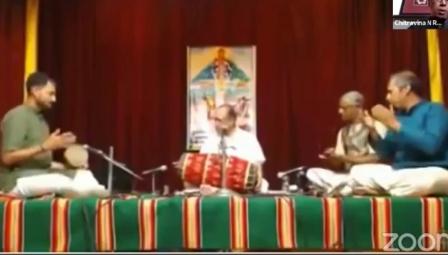Learn about the fundamentals of rhythm in Carnatic Music from the Perfecting Carnatic Music Level 1 Book published by IFCM.
Rhythm
Rhythm is inherent in almost every activity of nature. There is rhythm in the movements of cosmic bodies, as there is in the microcosmic.
Tala
Tala is the orderly physical expression of the rhythm inherent in music. In Carnatic music, this is done through beats, finger counts or waves of the hand. A tala has several parts. The three that are commonly used are:
|
Part
|
Symbol
|
Manner of rendering
|
|
Anudhrutam
|

|
A beat(1 unit)
|
|
Dhrutam
|
O
|
A beat and a wave of hand
|
|
Laghu
|
I
|
A beam followed by finger counts, starting from the little finger
|
Laghu can be of 5 types, depending on the number of units. These are called Jatis.
|
Jati
|
Symbol
|
Manner of rendering
|
|
Chaturastra Laghu
|
I4
|
Beat and 3 finger counts(4 units)
|
|
Tishra Laghu
|
I3
|
Beat and 2 finger counts(3 unites)
|
|
Mishra Laghu
|
I5
|
Beat and 4 finger counts(5 unites)
|
|
Khanda Laghu
|
I7
|
Beat and 6 finger counts(7 unites)
|
|
Sankeerna Laghu
|
I9
|
Beat and 8 finger counts(9 unites)
|
Note : The term ‘chaturashra’ is also referred to as ‘chatushra’.
System of 7 and 35 talas: Just as Carnatic music has a very orderly raga system, it has a highly organised tala system as well. The 7 basic talas are:
|
Tala
|
Part
|
|
Dhruva
|
Laghu, 1 Dhrutam and 2 Laghus(IoII)
|
|
Mathya
|
1 Laghu, 1 Dhrutam and 1 Laghu(IoI)
|
|
Roopakam
|
1 Dhrutam and 1 Laghu(oI)
|
|
Jampa
|
1 Laghu, 1 Anudhrutam and 1 Laghu(I o)
|
|
Triputa
|
1 Laghu and 2 Dhrutams(Ioo)
|
|
Ata
|
2 Laghus and 2 Dhrutams(IIoo)
|
|
Eka
|
1 Laghu(I)
|
As can be seen from the above, Laghu is common to all these talas. Since Laghu can be of 5 types, every one of these talas can permit 5 varieties. For instance, we can have Chaturashtra Dhruva tala, Tisra Dhruva tala, Mishra Dhruvatala, Khanda Dhruva tala and Sankeerna Dhruva tala. Similar combination of the rest of the talas add up to give us 35 talas.
The total number of units of a tala is determined by adding the units of the parts. For instance, Chaturashtra Dhruva tala had 4+2+4+4=14 units, while Tishra Dhruva tala has 3+2+3+3=11 units. Students are generally taught exercise(called Alankaras) in 7 of these 35 talas.
Variety by way of gati: Every unit the tala can have a certain number of internal counts. This internal pulse determines the gati of the tala, which is referred to as gati or nadai. Again there are 5 gatis.
|
Chaturashtra
|
One can render a tala in Chaturashra gati by saying the syllables of 4 units like ta-ka-dhi-mi, for every unit. Since Adi tala has 8 units, one will say ta-ka-dhi-mi 8 times.
|
|
Tishra
|
Ta-ki-ta(3 units)
|
|
Mishra
|
Ta-ka-dhi-mi-ta-ki-ta(7 units)
|
|
Khanda
|
Ta-ka-ta-ki-ta(5 units)
|
|
Sankeerna
|
Ta-ka-dhi-mi-ta-ka-ta-ki-ta(9 units)
|
Each of the 35 talams can be executed using these 5 gatis. For instance, we can have the same Khanda jati Mathya tala rendered in Chaturastra gati, Tishra gati, Mishra gati and so forth.
The internal count of a tala is determined by multiplying the total count by the gati. For instance, Khanda jati Mathya tala has 12 units. In Chaturashtra gati, it has 12 X 4 = 48 internal units. In Tishra gati, it has 12 X 3 = 36 units. The 35 tala varied by the 5 gatis give rise to 175 possibilities.
Prominent talas: There are hundreds of talas but the following are more prominently used.
|
Adi Tala
|
8 units per cycle(1 chaturashtra Laghu and 2 dhrutams)
|
|
Roopaka Tala
|
3 units(1 anudhrutam and 1 dhrutam)
|
|
Mishra Chapu
|
7 units(3 beats in ratio of 3:2:2)
|
|
Khanda Chapu
|
5 units(3 beats in ration 2:1:2)
|
It must be noted that the last 3 talas are abridged versions of Chaturashtra Rupakam, Tishra Triputa and Chaturashtra Mathya, respectively. The abridged versions are preferred by most composers and musicians except when the tempo of the composition is slow enough to allow one to render the original expanded version of the tala.
Students must give adequate importance to rhythm, familiarize themselves with these talas and also possess basic command over rhythmic, arithmetic, tempo and changes in gatis. Rhythm is as important as Melody, in Indian music, as conveyed succinctly by the ancient Sanskrit statement, Shrutir mata layah pita (melody is mother, rhythm is father)
To know more download the Perfecting Carnatic Music Level 1 Book.